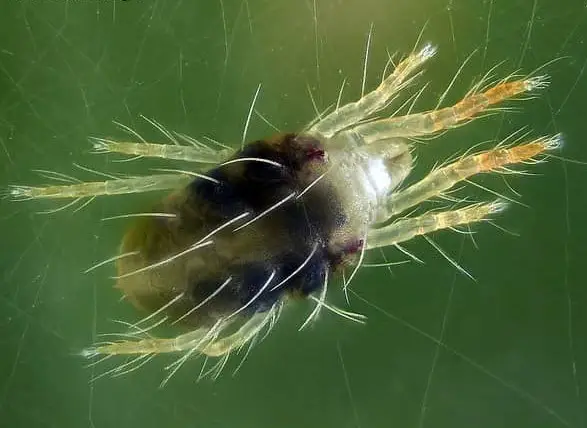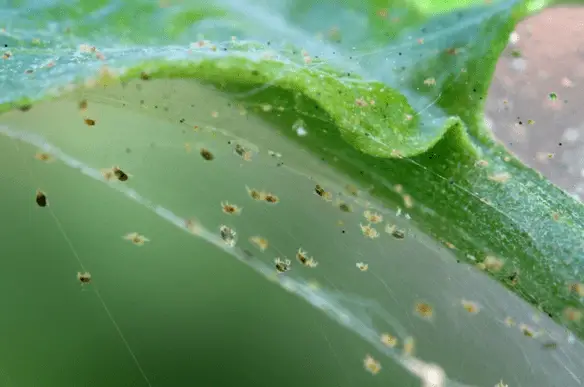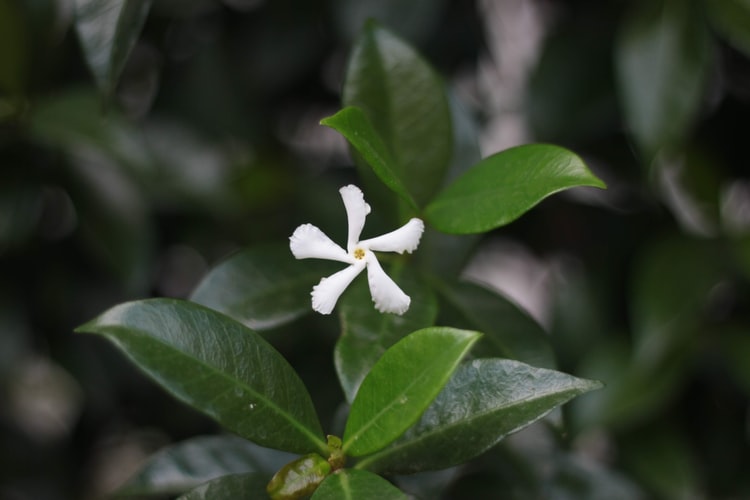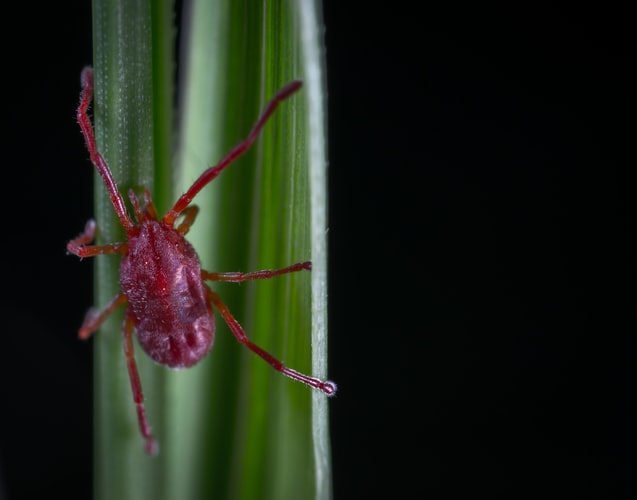Harvesting potatoes can be one of the most satisfying feelings ever. They are so delicious and easy to grow. However, it is very common during the cultivating season, you notice black or brown leaf spots on your potatoes. Most likely, the cause of those brown or black spots is due to some pests, insects, or diseases.
This time, I will introduce how to identify and deal with spots on potato leaves.
Causes of Black and Brown Leaf Spots on Potatoes
1. Pests and Insects
Every veggies plant is at risk of pest invasion. Now, it is common knowledge that ladybugs are garden-friendly because they are considered predators. They eat other tiny pests such as spider mites and aphids. However, for potatoes, we can find a very similar insect that resembles the ladybug called the Colorado potato beetle (Leptinotarsa decemlineata). This pest is very serious with strong resistance to insecticides.
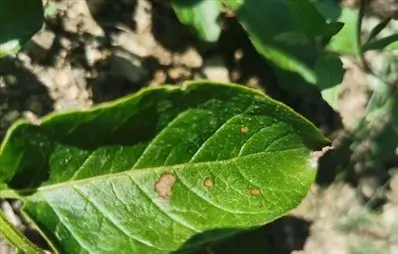
Photo Credit: niwa-hatake
The area infected by potato beetle is characterized by being thin. If you look closely at the brown spots, they may look like lace curtains.
Another insect that can be found on the leaves of potatoes is potato larvae. This kind of insect is very harmful to the plant. Once you notice one on your plant’s leaf, remove it immediately before it infests.
2. Potato Mosaic Disease
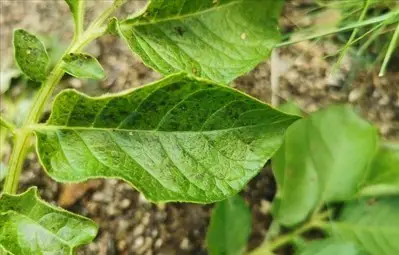
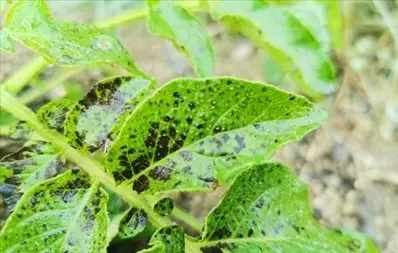
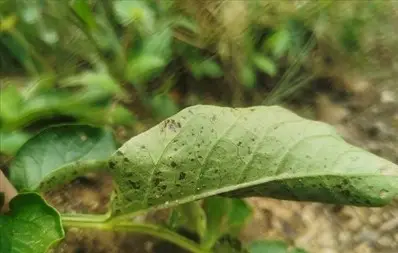
Potato mosaic disease is caused by a pathogenic virus. This virus is transmitted by species of potatoes and aphids. Mosaic brown patterns and black spots appear on the leaves of the potato. Once the plant is infected by this virus, the leaves shrink and become smaller through time, and then eventually the stems start to bent.
Potato mosaic disease is characterized by the formation of black spots. At first, it is thin, but as it progresses, it becomes darker and wider to cover the whole plant. The plant will stop growing and the plant height will decrease.
The back of the potato leaf will also be infected and dark spots appear on them. The leaf will also start to slightly curl. So there could be a possibility that your plant will be affected in the back of the leaf before the front. That’s why is always important to check and pay attention to your plants at all times.
As the mosaic disease progresses, the color becomes darker and the black part spreads along the veins. It can infect seed potatoes and spread through aphids. It often occurs before flowering.
Unfortunately, when it does occur, there is no cure, so remove it outside the field to prevent it from infecting other potatoes. Also, disinfect the soil where the disease occurs or avoid planting potatoes for several years. Sadly, it is that serious.
By the way, even if you have potato mosaic disease, you can still eat potatoes that the plant produced. It seems that many potatoes sold at supermarkets are already sick. It is harmless to humans.
3. Plague
The plague disease causes black spots on the leaves. And then after a while, the disease starts to spread to the whole plant covering all leaves.
It mainly occurs when the hyphae of pathogens are transmitted to the seed potatoes. So next time, maybe you should consider using virus-free seeds instead of your own harvested potatoes for seeds.
4. Early Blight
Early blight is a very common disease in potatoes. It is caused by Alternaria solani. This fungal disease can be confused with the brown spot disease Alternaria alternata. They are very similar as they both have brown spots on the leaf. The only difference is that through time, blight spots will grow larger while brown spots will have more spots on the leaves.
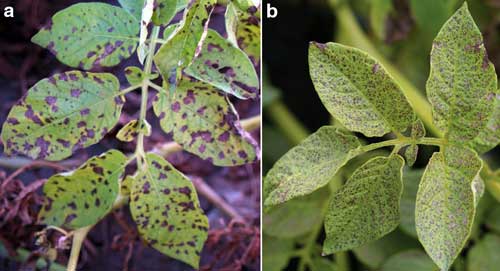
(b) symptoms of brown leaf spot on potato leaves caused by Alternaria alternata.
Photo credit: Willie Kirk and Phillip Wharton, MSU
5. Fungus
Fungus is also one of the main causes of brown leaf spots on potatoes Alternaria alternate. As I mentioned before, brown leaf spot is very similar to the early stages of blight as they are both pathogens. This disease is very common in potatoes. It is found in most potato-growing areas.
How to Control and Prevent Black and Brown Leaf Spots on Potatoes
Brown leaf spots can be treated using foliar fungicides and controlled by using cultural approaches.
Cultural approaches include crop rotation, removing and burning the infected leaves, and eradicating weed hosts help reduce the inoculum level for subsequent plantings. The following are methods to avoid and prevent brown and black leaf spots:
- 1. Proper irrigation.
- 2. Use certified disease-free seeds.
- 3. Aphid prevention.
- 4. Soil.
- 5. Chemical Prevention.
1. Proper Irrigation
Avoid watering your potato plant in cool, cloudy weather to allow the soil to dry before nightfall.
2. Use Virus-Free Seeds
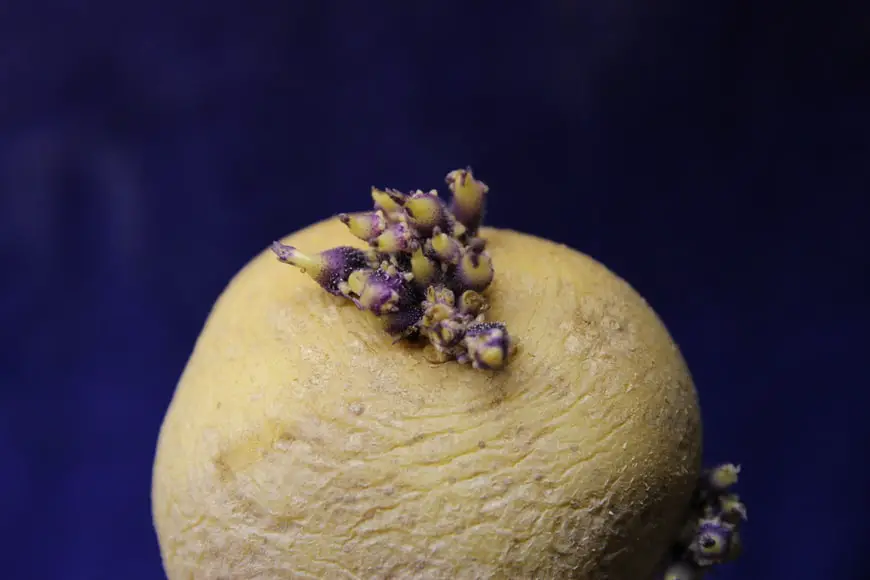
If you are using homemade seed potatoes, you may be infected with a disease (virus) at a certain stage. Once infected with a virus, it is difficult to get rid of it.
You can avoid that risk by purchasing new virus-free seed potatoes sold in garden stores, nurseries, or home improvement stores.
Also, when planting seed potatoes, it is advisable to sprinkle wood ash on the cut end to disinfect it.
3. Aphid Prevention
Aphids can occur on potatoes. Since aphids transmit viral diseases, it is important to prevent aphids in advance.
Control with an insect-repellent net or silver mulch, and if aphids occur on the leaves, spray diluted soapy water to kill the insects.
4. Soil
Potatoes grow well in well-drained, lean lands. Poor drainage or high nitrogen fertilizers make your plant more susceptible to disease.
You would also need to use tillage practices such as fall plowing which buries plant spoil.
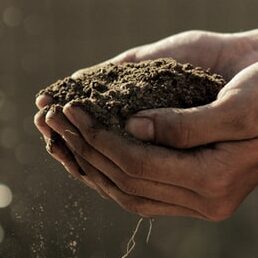
5. Chemical Prevention
In order to use a chemical product to control the brown leaf spots on potatoes, you’d first need to identify the cause. Once you know what caused your potato leaves to have either black or brown spots, you can decide on which chemical is best to use.
Here’s a list of the cause and chemical products you can use to control the disease of your plant:
- Insecticide or a Pesticide.
- Silver mulch
- Insect repellent net.
- Fungicide.
If your spots identify as a cause of pests and insects, you need to use an insecticide or a pesticide.
The mosaic disease has no cure but can be controlled. As mentioned before, aphids are responsible for transmitting mosaic disease to plants. So, in this case, you can use a pesticide as well to eliminate pests and control spreading.
In the case of the mosaic virus, you can also use an insect-repellent net or silver mulch to prevent aphids from invading. Aphids have the property that when they are exposed to light from below, they cannot feel the upper and lower sensations.
If the spots identify as a cause of early blight and brown leaf spots both can be controlled by using a fungicide. I must note that a study has shown that any fungicide containing strobilurins does not have any effect on the pathogen. The types of fungicides that showed efficacy against brown leaf spots contain famoxadone, pyrimethanil, fenamidone, and boscalid.
Note
In future cultivation of the potato, use an insecticide even before you notice any mosaic disease signs so that you can prevent pests to transmit the disease to your plant.

